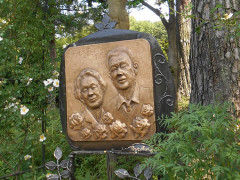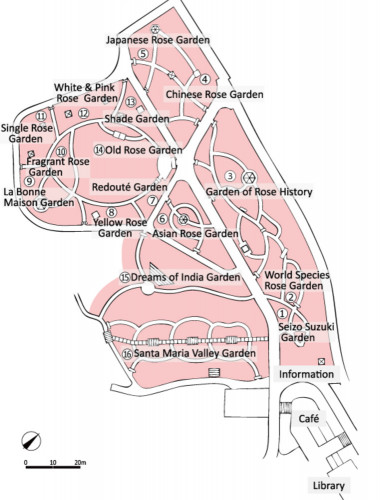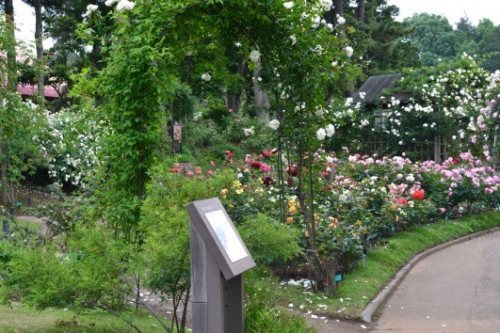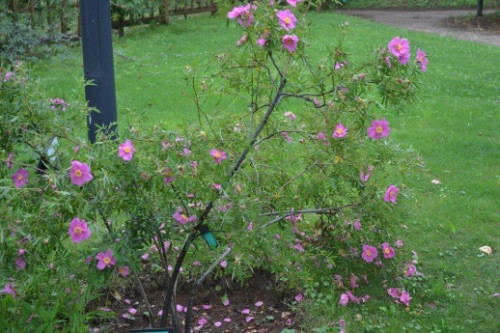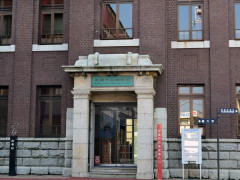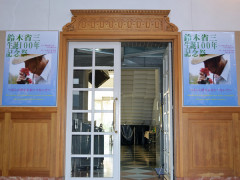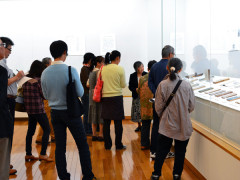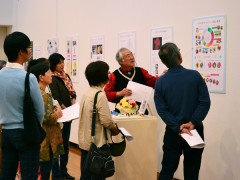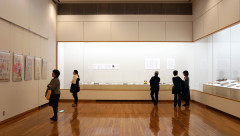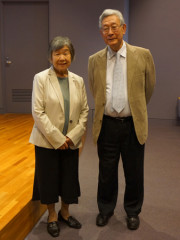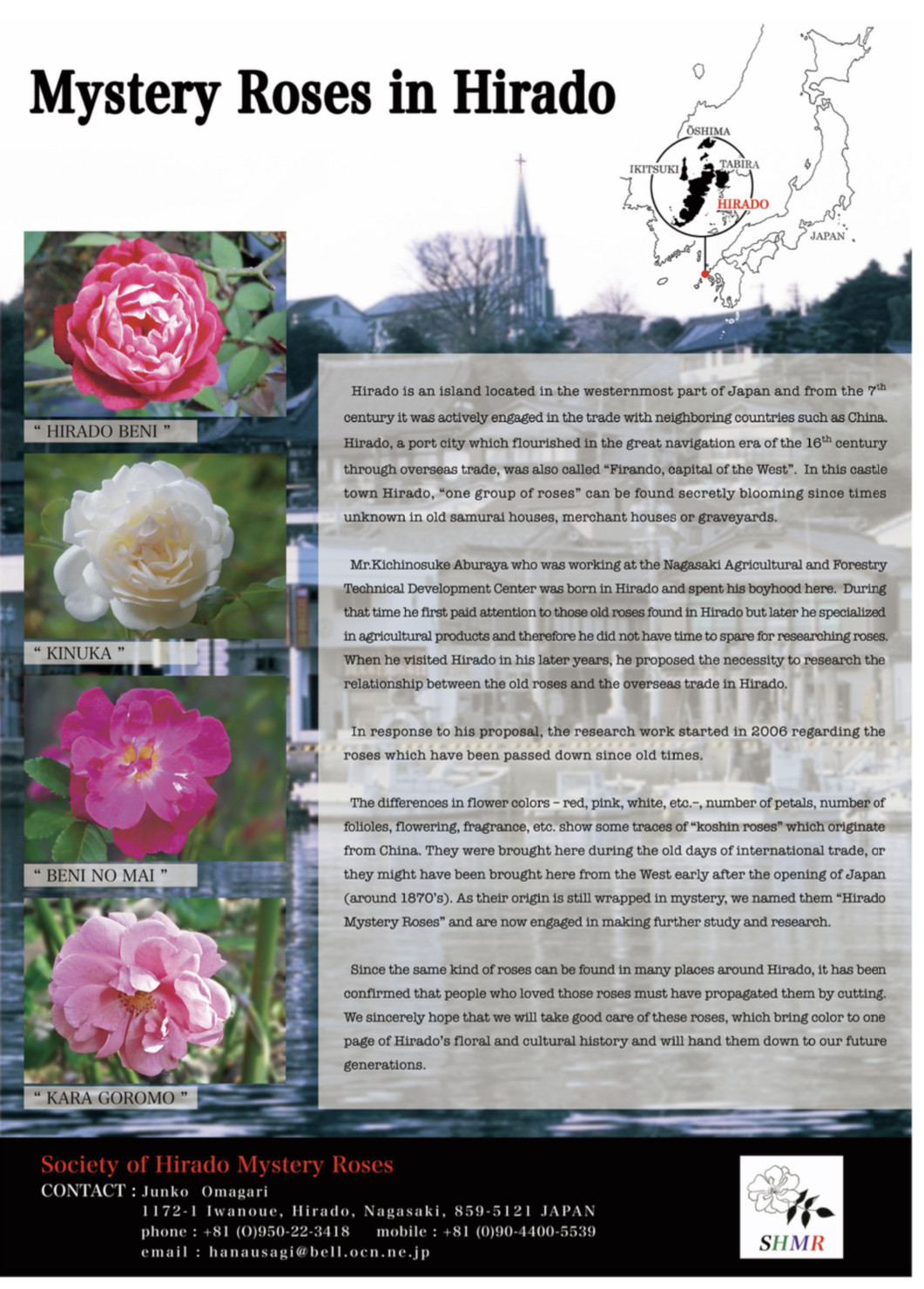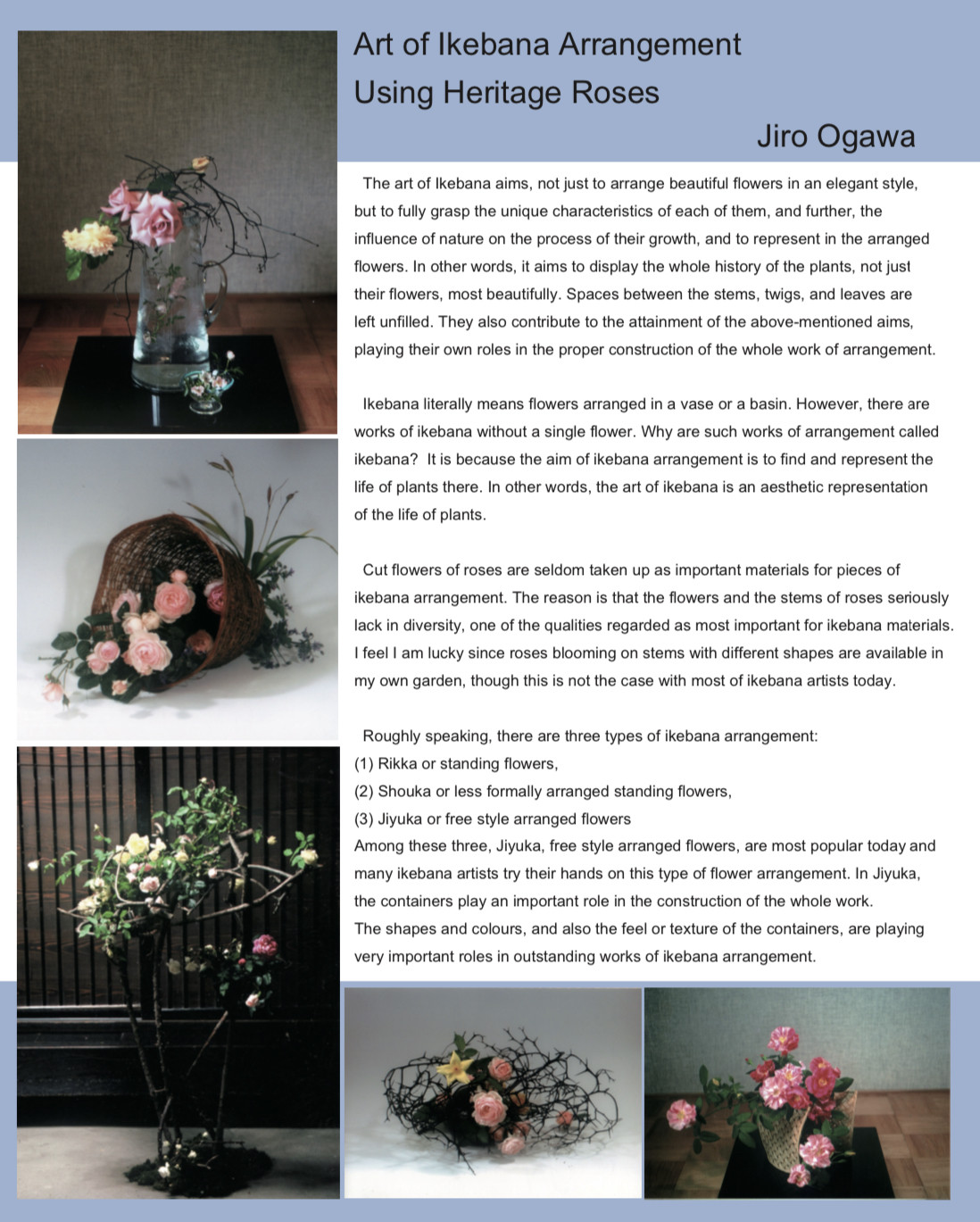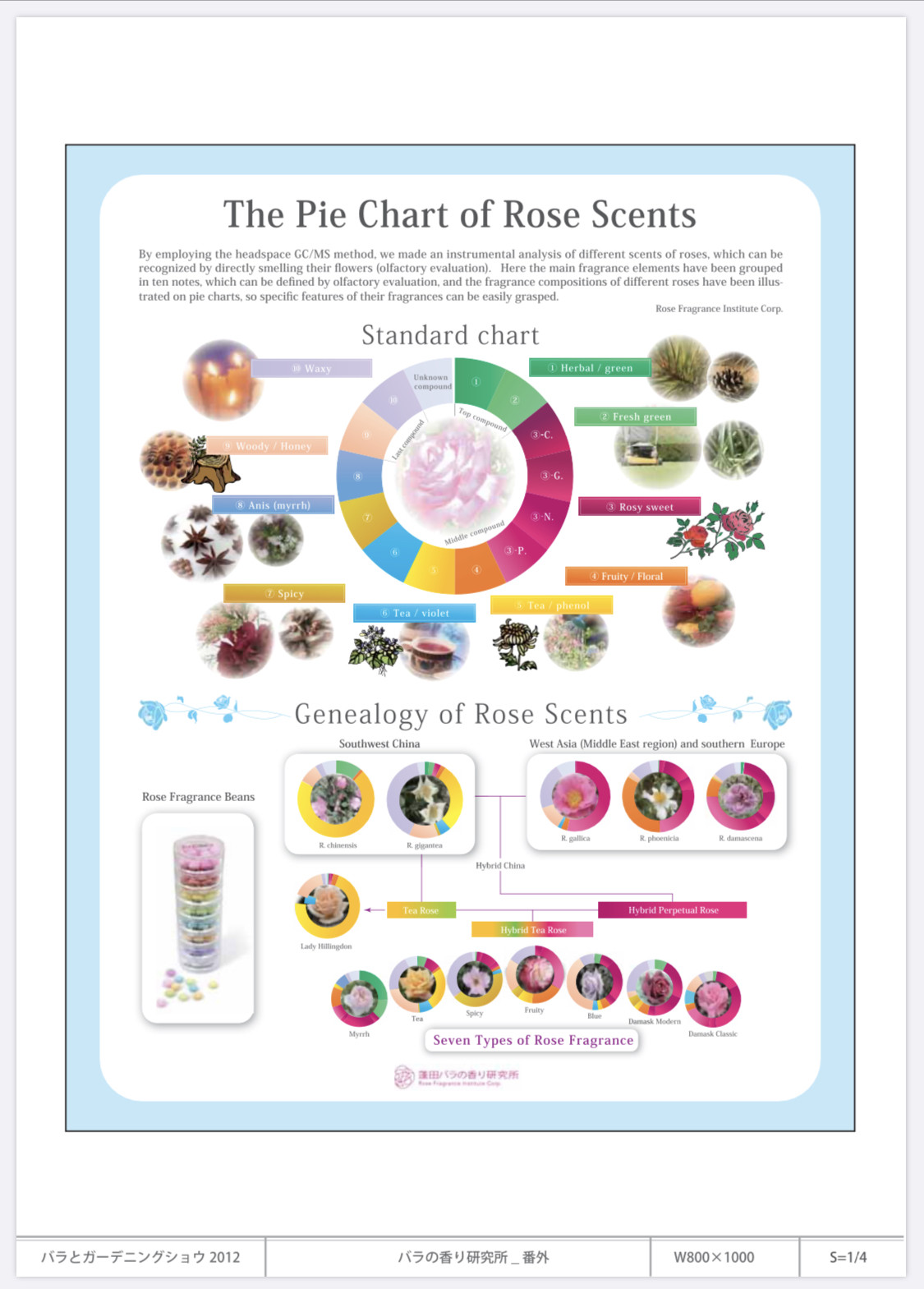English
Greetings from the director
Katsuhiko Maebara
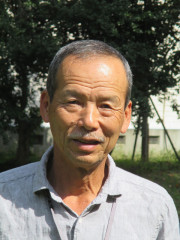
Since opening the City of Sakura Rose Garden in 2005, making a website in English has been our dream in order to convey the history and culture of roses in Japan, along with our latest research to rosarians of the world. I am very pleased that our website has been able to be launched from the beginning of August, 2014.
It is a great honor for us that our garden was chosen as a Hall of Fame Garden by the Great Rosarians of the World, Program 2014. On behalf of all the members of the institute, I would like to extend my sincerest gratitude.
About forty years ago, I stayed in San Francisco for two years in order to learn horticulture. Twenty years ago, I established the Rose Culture Institute, and since then, have always run it on the model of the Huntington Rose Garden, from which I learned how to manage a public rose garden, to collect and preserve precious rose species and varieties, in addition to how to nurture them with the help of volunteers. Being chosen as a Hall of Fame Garden is encouragement greater than anything else for all the institute members and volunteers.
We would like to continue our work, in cooperation with Sakura City, to maintain and improve our rose garden. We welcome you to visit our garden virtually through this website and hope it will help rosarians of the world and all nature enthusiasts to understand Japan's history, culture, and contributions with roses. Also, I hope your virtual visit will encourage you to have a chance to come and visit our garden in person, to walk through the various areas enjoying the beauty created through the legacy, work, help, and collaboration of many.
History
-THe Rose Culture Institute and the City of Sakura Rose Garden-
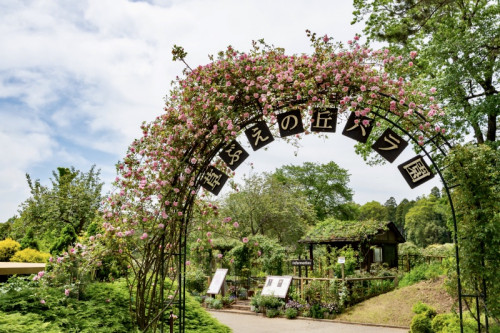
The Rose Culture Institute was established in 1995, and was registered by Chiba Prefecture as an non-profit organisation on the 18th of Jan. 2000. It is managed by an operating committee with six members and two full-time employees. On the 15th of May, 1996, it opened Rose Garden Alba, a garden specialising in collecting and preserving heritage roses. It was a forerunner of gardens of this kind in Japan, and helped many rose lovers to open their eyes to the beauty and importance of species and old garden roses.
While the garden enjoyed growing popularity among rose lovers, the increasing number of the varieties it had collected soon outgrew its capacity. In 2006, in cooperation with Sakura City, the institute newly opened the City of Sakura Rose Garden (Kusabue-no-oka ) on city land. Just a month after its opening, over 70 rose experts from abroad visited the garden on a tour after the World Federation of Rose Societies (WFRS) World Convention held in Osaka. Greatly encouraged by their kind words on the garden, and particularly by the suggestion of Mrs. Odile Masquelier, Katsuhiko Maebara and members of the NPO Rose Cultural Institute decided to invite an international rose conference to Sakura! Even though the conference had to be postponed for one year because of the terrible earthquake, tsunamis, and the calamities of a nuclear power station, excitement about hosting the conference and perseverance remained strong and the 12th WFRS International Heritage Rose Conference in Sakura was held in 2012.
The institute has been entrusted with the maintenance and management of this 13,000㎡ (3.2 acre) new garden with 2,500 plants of 1,050 different species and varieties. All the work is done by volunteers, 3,000 man hours per year. Small paths, pergolas, and benches in the garden were all built by the hands of these volunteer workers.
The rose garden is divided into sections specialising in different types of roses so visitors can easily learn about the unique features of species and old garden roses, and also the history of their development. In addition, we are aiming at a rose garden which will harmonise with the traditional landscape of Japanese countryside, where visitors can feel at home, and fully enjoy delicate colours and fragrances of the flowers.
The core of the collection is the varieties transplanted from Rose Garden Alba, but the collection has been greatly enriched by many precious species and varieties kindly donated by rose lovers in different countries of the world, including France, Italy, India, Australia, Japan, etc. We expect that our guests will be impressed not just by beautiful flowers, but by the goodwill and warm friendships developed through the common love of of roses among rosarians of the world.
The garden was honored in being chosen as a Hall of Fame Garden by the Great Rosarians of the World (GROW), Program 2014. We look forward to continuing to nurture the garden along with the City of Sakura for many to be able to enjoy for years to come
Mr.Rose, Seizo Suzuki
Mr.Rose, Seizo Suzuki (1913-2000)
Seizo Suzuki opened a rose nursery in Tokyo when he was 24 years old. In 1958, he was invited into the Research Institute of Keisei Rose Nursery as its director. There he engaged in research of roses and in breeding new roses until he retired in 1993.
In an effort to create original new roses, he always strove for an effective breeding method fully based on scientific knowledge. He was particularly interested in the mechanism of biosynthesis of pigments and fragrances in rose flowers. Throughout his over 60 year breeding career, he raised as many as 129 new rose varieties, including 'Seika' ('Olympic Torch'; Gold Star of the South Pacific, New Zealand, 1972), 'Kampai' ('Cheers!', Grand Prize at Rome, 1982), and 'Kosai' ('Mikado', AARS, 1988).
While rigorously investigating the charms of roses through scientific methods, he also considered that an extensive knowledge of the history of roses and rose-related art is essential for breeders. The books he wrote, which reflect his far-reaching interest in the botanical, historical, and artistic study of roses, have had a strong influence on all rose lovers and breeders in Japan. The lectures he gave on TV gardening programmes also spread the joy of rose growing among Japanese gardeners.
He fully realised the importance of wild species and old garden roses in the early period of his career --in the 1960's, and established a great collection of heritage roses at the research institute of Keisei Rose Nursery. The number of rose varieties and species he collected supposedly reached almost 2,000. Mr. Peter Harkness, who saw the collection in 1993, wrote: "For quality of growth and richness of variety I have never seen its like. I could have stayed for days." (The Rose, RNRS, Christmas 1993). When Mr. Suzuki retired from the work of Keisei Rose Nursery, one of his disciples, Katsuhiko Maebara, took over part of this collection, which laid the basis for the collection of the City of Sakura Rose Garden (Kusabue-no-oka) today
Garden Map
The rose garden is divided into 16 sections. We are aiming at a rose garden which will harmonise with the traditional landscape of the Japanese countryside, where visitors can feel at home, and fully enjoy the delicate colours and fragrances of the flowers.
① Seizo Suzuki Garden (SS)
Roses bred by Seizo Suzuki are planted near the entrance of the garden. The white arch in this garden was given to Mr. Maebara by Mr. Suzuki, when he closed his first rose nursery, Todoroki-baraen.
In October 2013, Mr. Kojiro Kobayashi, grandson of Mr. Seizo Suzuki, donated a beautiful relief sculpture of his grandparents to the City of Sakura Rose Garden. It was wonderful to celebrate Mr. Suzuki’s birth centenary with such a thoughtful gift!
② World Species Rose Garden (WS)
Living in Asia, we can seldom see species roses from North America; Rosa foliolosa, R. setigera, and those from Europe; R. arvensis, R. sempervirens, etc. Recently, Japanese rosarians are eager to deepen their knowledge of heritage roses. They will be very happy to see many of these wild roses in this garden.
③ Garden of Rose History (H)
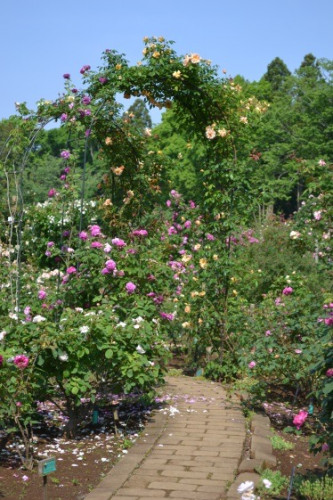
Roses are planted in this garden so we can learn their history of breeding: from ancient varieties in China, Europe, to modern roses. We are very grateful to the Vintage Gardens and Mr. Gregg Lowery for their gift of rare antique roses planted in this garden.
④ Chinese Rose Garden (Ch)
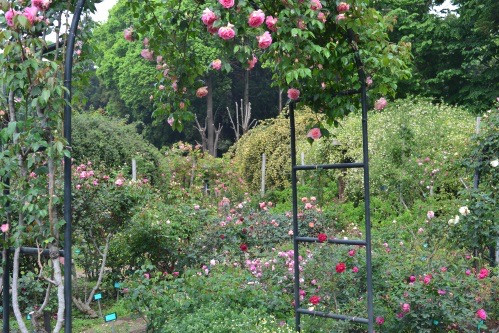
Roses from China and varieties of China roses are planted in this garden. Please check a rose which is very similar to ‘Hume's Blush Tea-scented China’ found in Laos by Mr. Maebara and Prof. Ueda. You can see roses from Huaian Rose Garden (Jiangsu Province, China), here, too. They are all with Chinese names, like ‘Shui Mei Ren’, which means Sleeping Beauty.
⑤ Japanese Rose Garden (J)
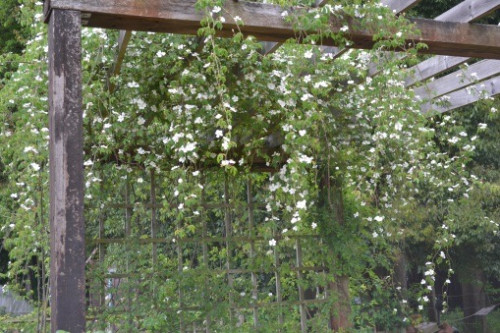
All kinds of wild species from Japan and their offsprings are represented here.
⑥ Asian Rose Garden (A)
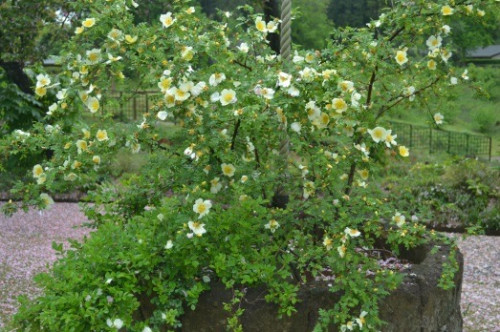
R. gigantea from Yunnan and India, R. rubus and R. multiflora var. cathayensis from Sichuan, and many other species roses from Asian countries are planted in this garden.
⑦ Redouté Garden (R)
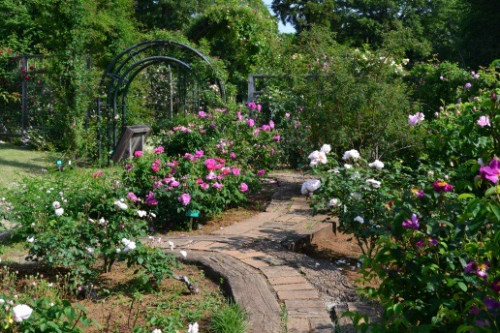
Redouté, widely known as a rose painter, painted 169 roses (89 cultivars and 80 wild roses) for his Les Roses. However, of all those cultivars he painted, only twenty or so still remain today. In this garden, you can see 17 cultivars and 5 wild roses he painted. When you see them giving the same flowers as those in his pictures, you will be impressed with the wonder of roses which have long retained their beauty by man's skills of grafting and cutting.
⑧ Yellow Rose Garden (Y)
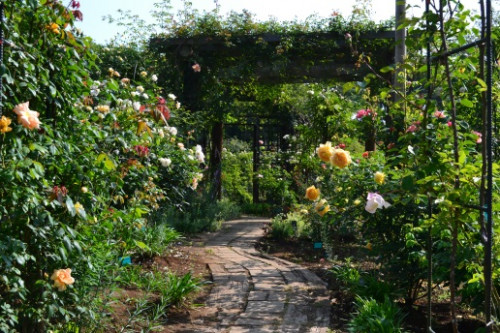
A relatively small number of heritage roses give yellow flowers. Though bright yellow colours are attractive, they sometimes disturb the harmony of colours in the landscape if placed in the wrong positions in designing a garden. We collected yellow roses here with a view to fully bringing out the beauty of their colours.
⑨ La Bonne Maison Garden (BM)
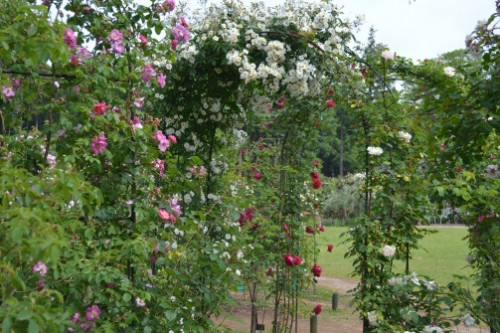
La Bonne Maison, Mrs. Odile Masquelier's garden in Lyon, is famous for its excellent collection of roses and its beautiful design. The number of roses carefully selected from her collection and donated to us is now up to 200. They are planted here, and fascinate visitors every flowering season.
⑩ Fragrant Rose Garden (F)
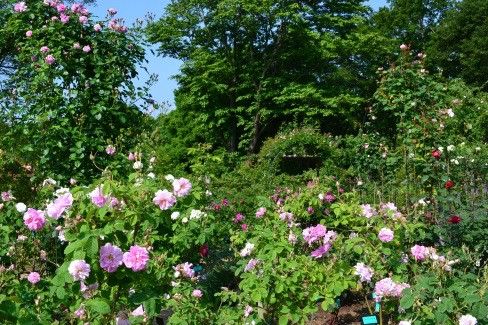
The poll we conducted among our volunteers revealed that they liked ‘Lijiang Road Climber’ best of all the roses in the garden. It was because of the gorgeous flowers it gives early in spring, and their sweet tea fragrance. In recent years rose lovers in Japan have come to place much more importance on fragrance. This garden, where roses featuring their unique fragrances are planted, will fully satisfy their interest.
⑪ Single Rose Garden (Si)
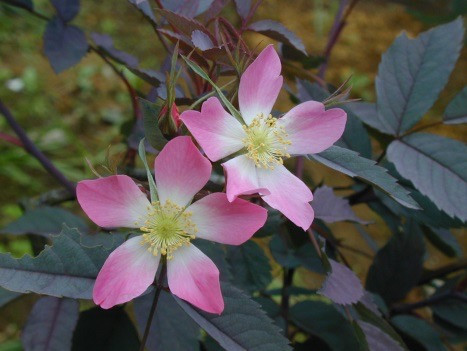
All the wild roses give single flowers. This garden displays not just wild species but also cultivars such as ‘Red Nelly’, ‘Francis E. Lester’, ‘Sally Holmes’ and ‘Nozomi’. They are all single roses which attract our attention with their unique shapes and colours as well as their fragrances.
⑫ White & Pink Rose Garden (WP)
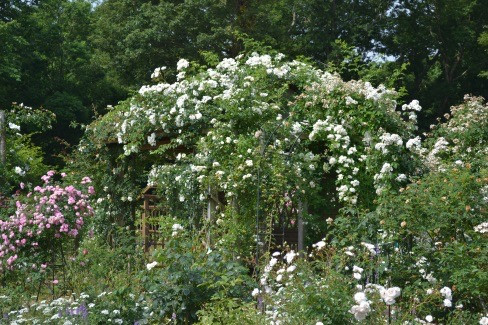
By far the largest number of heritage roses give white or pink flowers. On one side of the glass plot opposite to the Yellow Rose Garden, we planted roses with white or pink flowers. Please enjoy the blissful time sitting on a bench placed in the small cottage in this garden.
⑬ Shade Garden (Sh)

When we plant roses in our garden, we often want to have some roses which grow in good health and give flowers even in places which do not get plenty of sunshine. Here forty or so such roses are planted under the shade of a pergola thickly covered with the canes of ‘Seagull’, ‘Tea Rambler’ and other climbing roses.
⑭ Old Rose Garden (O)
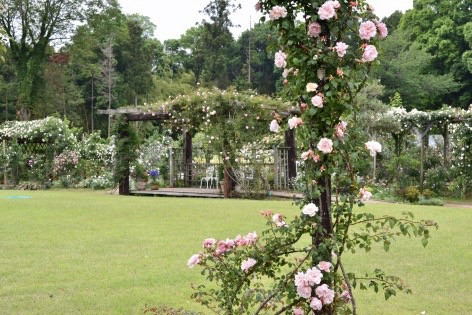
There is a large grass plot in the centre of the garden. ‘François Juranville’ and ‘Blue Magenta’ spread their canes over the wooden stage on one side of the plot. The tall poles and festoons around the plot are all covered with flowers of ‘Bobby James’, ‘Treasure Trove’, ‘Veilchenblau’, and other climbers - a gorgeous look!
⑮ Dream of India Garden (DI)
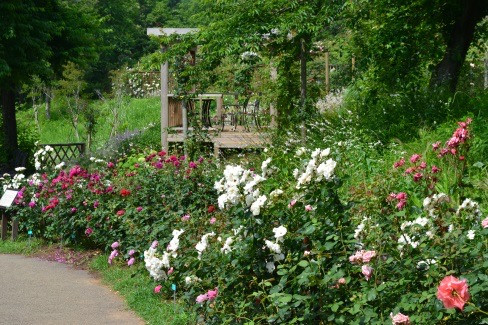
Mr. Viru Viraraghavan, a noted breeder from India, has created many rose varieties suited to the hot climate of the South Asian countries, using Rosa gigantea and other wild roses. Mr. and Mrs. Viraraghavan have so far provided us with a lot of rose-related information, and have donated to our rose garden 27 cultivars they bred. We have opened a new section named “Dream of India Garden” and planted their roses and other hybrid giganteas there.
⑯ Santa Maria Valley Garden (SM)
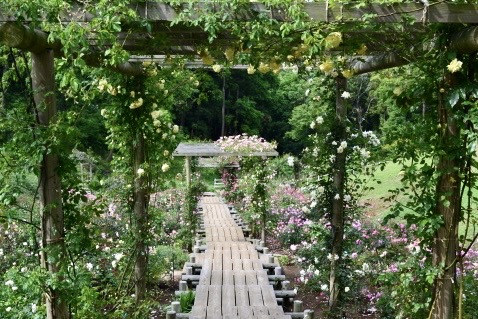
Mrs Helga Brichet, Italy, kindly donated to us as many as 184 different varieties of roses including many rare China roses and Hybrid Giganteas. They are planted in the section facing the garden shop, named “Santa Maria Valley Garden” after Mr. and Mrs. Brichet's residence. Though “Santa Maria” in Perugia is located on a gently sloping hill in the central area of Italy, we chose a south facing slope of the valley for planting Mrs. Brichet's roses, so that we can view from above the tapestry of marvelous colours many China roses display.
Library (L)
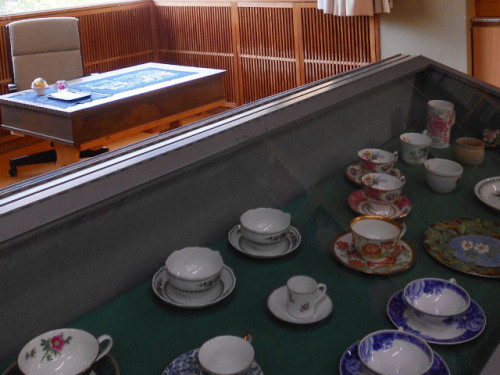
Mr. Suzuki's wife, Mrs. Haruyo Suzuki, has donated her husband's private library and favorite gardening tools, such as his secateurs, to Sakura City, and members of the Rose Culture Institute manage these precious gifts accessible to all the rose lovers who visit this rose garden. Please come to the library next to the rose café.
The Festival for Mr. Seizo Suzuki's Birth Centenary
◆Lecture Series No. 1 (2013/11/01)
Mrs. Kazuko Nomura and Prof. Hideaki Ohba
 |
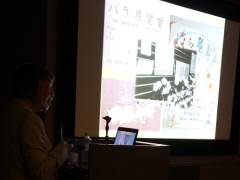 |
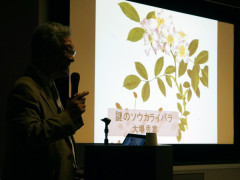 |
|
|
◆Mr. Alain Meilland's Garden Talk at Keisei Rose Garden (2013/11/02)
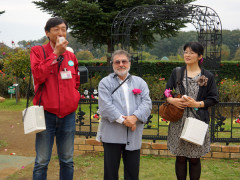 |
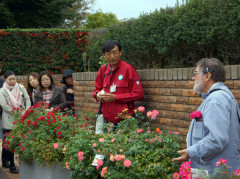 |
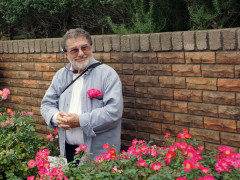 |
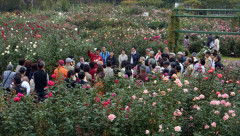 |
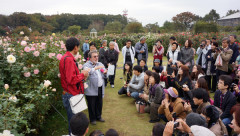 |
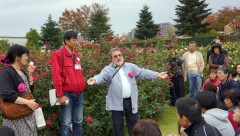 |
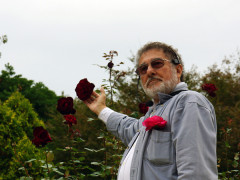 |
◆The Festival for Mr. Seizo Suzuki's Birth Centenary (2013/11/03)
Keynote Speech by Mr. Alain Meilland (Interpreter: Mr. Johji Nishio) and Breeder's Panel: Mr. Teizo Yoshiike, Mr. Shunsuke Takeuchi, Mr. Takashi Kawai and Mr. Alain Meilland
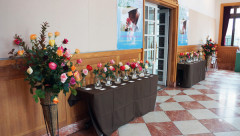 |
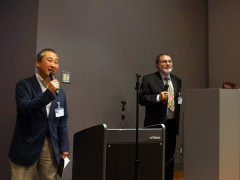 |
 |
 |
◆The Festival for Mr. Seizo Suzuki's Birth Centenary Lecture Series No. 2 (2013/11/09)
Mr. Katsuyuki Yomogida
Panel Discussion: Mr. Tsuneo Kaneko, Mr. Tamiya Saito, Mrs. Kazuko Nomura and Yuki Mikanagi
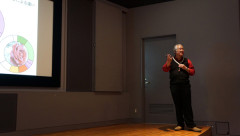 |
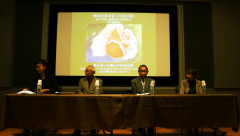 |
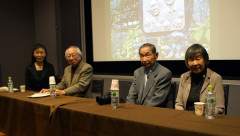 |
◆The Festival for Mr. Seizo Suzuki's Birth Centenary Lecture Series No. 3 (2013/11/10)
Mr. Katsuhiko Maebara, Prof. Yoshihiro Ueda, and Mr. Shunsuke Takechi
 |
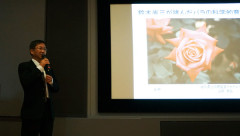 |
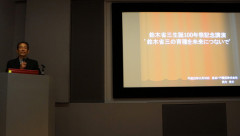 |
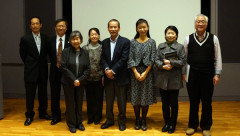 |
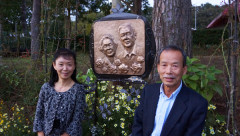 |
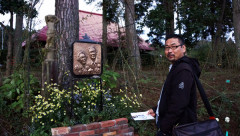 |
Wild Roses in Japan
Yuki Mikanagi Ph.D
Natural History Museum and Institute, Chiba
Among the wild roses native to Japan, Rosa multiflora, R. luciae ( = R. wichuraiana) , and R. rugosa are widely known since they were taken to Europe in the nineteenth century or even earlier, and the former two have transferred their genes to many roses grown in our gardens today. However, roses growing wild in Japan are by no means confined to these three. In fact, there are more than a dozen wild roses growing naturally in various parts of this country. In this paper, the author is going to follow the classificatory method taken by Prof. Hideaki Ohba (Flora of Japan IIb, 2001) with a slight alteration.
The genus Rosa is divided into four subgenera. Of these four, roses belonging to two subgenera, Rosa (syn. = Eurosa) and Platyrhodon are found growing wild in Japan. Only one species Rosa hirtula ("Sansho-bara" in Japanese) is classified in subgenus Platyrhodon, and the others are in subgenus Rosa. Japanese wild roses classified in the subgenus Rosa are further divided into three sections: Synstylae, Rosa, and Bracteatae.
◆ Section Synstylae
SPECIES and VARIETIES
Flowers of Synstylae roses have a projecting column of styles (styles are the stalks of stigma). Normally, they give a large number of small white flowers with strong musky scent in large clusters.
(1)-1 No-Ibara (Field Briar)
R. multiflora Thunb. var. multiflora
(syn. = R. polyantha Siebold et Zucc.)
Murray. Syst. Veg. ed. 14. 474 (1784)
Distribution: SW-Hokkaido, Lowlands in Honshu, Shikoku, and Kyushu.
R. multiflora grows naturally in many parts of Japan. Among the white-flowered wild roses growing in this country, only this rose has no pubescence on the surface of its united styles of pistils, so it is easy to determine its identity if we examine the flower with a magnifying glass. As its epithet indicates, the feature of R. multiflora is its big panicles with many flowers. However, there are a considerable number of local variations. In general, those found in northern areas, especially those in the Tohoku district on the Sea of Japan side, bear large flowers and inflorescences, which gradually become smaller in size as we come down to southern areas. The average size of the flower is between 1.8 and 2.3 cm across. Even smaller flowers we find in southern areas give off a wonderful sweet fragrance. If we voted for the champion of fragrant wild roses, R. multiflora would be the sure winner.
This is the rose famous for the roles it played as the ancestor of many cultivated roses, such as Multiflora Ramblers, Polyanthas, and Floribundas. It is also very familiar to us as commonly used rootstock in Japan. Fruits of R. multiflora are called ‘Ei-jitsu‘, and have been used in traditional Chinese medicine for their strong diuretic effects.
(1)-2 Tsukushi-Ibara (Briar from Tsukushi, Kyushu)
R. multiflora Thunb. var. adenochaeta (Koidz.) Ohwi ex H. Ohba
Flora of Japan: 171 (2001)
Distribution: Honshu (western parts of the Chugoku district) and Kyushu
Though this rose is generally considered to be a variety of R. multiflora, the author suspects that it could be a hybrid between R. multiflora and some other roses. Its flowers make a big panicle like R. multiflora, but their colour is varying shades of pink, and the whole bush, spreading its canes very vigorously, is larger than R. multiflora. It also differs from R. multiflora in that it has glandular hairs on its peduncles, calyx tubes, and the outer surface of its sepals. Sometimes this rose is confused with a wild variety in SW China, R. multiflora var. cathayensis Rehder et Wilson, but flowers of var. cathayensis make small corymbs, and have no glandular hairs like var. adenochaeta. The large colony of R. multiflora var. adenochaeta on the banks of the Kuma River in Kumamoto Prefecture, Kyushu, is widely known for its breathtaking appearance when the roses are fully in bloom. This variety is also used as an understock rose in Japan.
(2)Yama-Ibara (Mountain Briar)
R. sambucina Koidz.
Bot. Mag. Tokyo 31: 130 (1917)
Distribution: West Honshu (Aichi Prefecture and further west, the Kinki district, the Chugoku district), Shikoku and Kyushu
The flowers of this rose resemble those of R. multiflora in shape; however, this rose grows more vigorously and puts forth longer stems which sometimes climb on other trees. Its flowers are larger than those of R. multiflora, ca. 3.5 cm across, and also leaves with 3 to 5 leaflets are much larger than those of R. multiflora. The shape of its inflorescence also differs: unlike other roses in this section, whose flowers are arranged in panicles, this rose bears its flowers in big corymbs. The scenery with this rose in full bloom sometimes reminds us of a magnificent white cascade rushing over evergreen forest.
(3)Teriha-No-Ibara (Shiny Leaved Field Briar)
R. luciae Rochebr. et Franch. ex Crép.
(syn. = R. wichuraiana Crép.)
Bull. Soc. Roy. Bot. Belgique 10: 324 (1871)
Distribution: Honshu, Shikoku, Kyushu
R. luciae is usually found on the seashore, or on river banks, but sometimes in grassland on high mountains. It blooms later than most other wild roses in section Synstylae. In areas near Tokyo, R. multiflora and R. onoei var. oligantha come in bloom in May, but R. luciae blooms much later, toward Mid-June or in early July. It bears white flowers 3 to 3.5 cm across, a little larger than those of R. multiflora. Its inflorescence widely differs in size: some flowers are borne singly, some in large clusters. Shiny round leaflets and canes spreading sideways in a zigzag pattern are its conspicuous features. Its long creeping branches have been inherited by its descendants Wichuraiana Ramblers.
(3)-2 Ryukyu-Teriha-No-Ibara (Shiny Leaved Field Briar from Ryukyu)
R. luciae Rochebr. et Franch. ex Crép. f. glandulifera (Koidz.) H. Ohba
(syn. = R. wichuraiana Crép. var. glandulifera (Koidz.) Honda)
Flora of Japan; 172 (2001)
Distribution: Southern Kyushu and Okinawa (Ryukyu) islands
This is a kind of local variation of R. luciae (= R. wichuraiana) with thick glandular hairs on its inflorescence and calyx, found in southern parts of Japan. One of the selected varieties from Yakushina island flowers remontantly, and in autumn, white flowers and red fruits display a beautiful colour combination
(4)Yabu-Ibara (Thicket Briar)
R. onoei Makino var. onoei
Bot. Mag. Tokyo 23: 147 (1909)
Distribution: SW-Honshu (south of the Median Tectonic Line), Shikoku, and Kyushu
This is the wild rose with the smallest leaves and flowers in Japan: the size of flowers is ca. 1.5 cm, and its peduncle and calyx are normally villous. The hips are small and almost globular, 5 to 6 mm across. A local variation of this rose in Shikoku bears particularly small flowers. Its long terminal leaflet is another feature of this rose.
(4)-2 Mori-Ibara (Forest Briar)
R. onoei Makino var. hakonensis (Franch. et Sav.) H. Ohba
(syn. = R. jasminoides Koidz.)
J. Jap. Bot. 75: 161 (2000)
Distribution: Mountainous areas, mainly chestnut ranges, in Honshu (the Kanto district and further west), Shikoku, and Kyushu. No distribution on the Japan Sea side of the Archipelago.
R. onoei var. hakonensis grows naturally in mountainous areas on the Pacific side of Honshu, and in Shikoku and Kyushu. It has a good shade tolerance in woody areas. The specific epithet of the synonym of this rose “jasminoides”, meaning “jasmine-like”, seems to suggest that this is a highly fragrant rose, but its flowers have just a slight sweet scent. The author suspects that the epithet might have come from the shape of its leaves, but so far she has been unable to find a definite answer. Though its single white flowers, about 2.5 cm across also resemble those of R. multiflora, they are not borne in large clusters in a natural environment, just one or two of them coming at the end of the stem. It produces long, thick peduncles with glandular hairs, and bears oval hips 7 to 12 mm across.
(4)-3 Azuma-Ibara (Eastland Briar)
syn. = Oo-Fuji-Ibara (Large Fuji Briar)
syn. = Yama-Teriha-No-Ibara (Mountain Shiny Leaved Field Briar)
R. onoei Makino var. oligantha (Franch. et Sav.) H. Ohba
(syn. = R. luciae Franch. et Rochebr.)
J. Jap. Bot. 75: 157 (2000)
Distribution: Downs and lower mountains in Honshu (Miyagi Prefecture and further south, and Toyokawa, Aichi Prefecture and further east)
As the Japanese name “Yama-Teriha-No-Ibara” indicates, it has glossy leaves and is often confused with “Teriha-No-Ibara” (R. luciae). However, its leaflets are not as round as those of R. luciae. The tree shape also differs. Unlike R. luciae, which spreads sideways hugging the ground, this rose grows upwards, sometimes climbing up trees using its prickles, three to four metres tall, and sometimes hangs down a steep slope. While the number of leaflets is 7 to 9 for R. multiflora and R. luciae, 5 to 7 is normal for all the R. onoei varieties, including var. oligantha. The flowers are white, 2 to 2.5 cm across, and closely resemble those of R. multiflora. However, this rose has thick hairs on its styles, while R. multiflora has none.
(5)Miyako-Ibara (Capital (Kyoto) Briar)
R. paniculigera (Makino ex Koidz.) Momiy.
Acta Phytotax. Geobot. 20: 26 (1962)
Distribution: SW-Honshu (western parts of Shizuoka Prefecture, Niigata Prefecture, and further west), N-Shikoku, N-Kyushu
R. paniculigera also closely resembles R. multiflora, bearing a lot of white flowers (ca. 1.8 cm across, a bit smaller than those of R. multiflora) in large panicles. However, its stems, petioles, and canes are thickly covered with glandular hairs, and its styles also have hairs?Its flowering period is a little later than that of R. multiflora.
(6)Fuji-Ibara (Fuji Briar)
R. fujisanensis (Makino) Makino
Bot. Mag. Tokyo 27: 151 (1913)
Distribution: High mountains in the central area of Honshu, and in Shikoku
A large colony dominated by this rose can be seen around the peak of Mt. Mitsutouge in Yamanashi Prefecture near Mt. Fuji. This is a rose with thick main stems which often grow over 10 cm across and densely put forth small branches. Its leaflets are dark green, and roundish in shape. The flowers are white, 2.5 to 3.0 cm across, and are arranged in panicles. The number of the flowers in a panicle differs widely, ranging from one to 20.
◆ Section Rosa (= sect. Cinnamomeae)
We saw that most of the roses in the Synstylae section bear small white flowers. Roses in the sect. Rosa bear pink-purple flowers which are much larger than those of Synstylae taxa, and look very gorgeous and attractive. Their flowers have a typical spicy fragrance.
(7)Hama-nasu (Shore Aubergine)
syn. = Hama-Nashi (Shore Pear)
R. rugosa Thunb.
Murray, Syst. Veg. ed. 14:473 (1784)
Distribution: Hokkaido, Honshu
R. rugosa is distributed in the northern parts of Japan, mainly in coastal areas. This is the prefectural flower of Hokkaido, and there are some famous sights featuring Rugosa flowers on this island. We can also see this rose in Honshu, north of Chiba Prefecture on the Pacific coast, and north of Shimane Prefecture on the Japan Sea coast.
When we visit the south end of its natural habitat in Chiba Prefecture in Kuju-Kuri Town, we can find a small area dominated by R. rugosa under conservation by the town? Actually, it presents a somewhat sad-looking sight, protected by a barbed wire fence, by the side of a rubbish dumping ground! It is a relief to hear that the roses there give a lot of flowers every year.
The author has seen naturally growing R. rugosa in many different places. In Sado Island in the Sea of Japan, she saw a bush growing by the sea as if clinging to the rocky beach. On a beach in Hokkaido facing the Okhotsk Sea, it was blooming on a sandy stretch swept by cold winds. A beach which is constantly sprayed with sea water would not allow even this rose to survive, but it does not seem to mind a harsh wind from the sea. The author saw this rose beautifully in bloom where few other plants were seen growing.
It is famous as an ancestral rose of Hybrid Rugosas in European countries, and for long years, Japanese people have enjoyed its sweet fragrance, and also used petals and fruits of this rose for sweet preserves. In Akita Prefecture, the bark and roots of R. rugosa are sources of important dyes for dying traditional fabrics called ‘Akita Ki-Hachijo’ (Checkered Yellow Cloth from Akita).
(8)Karafuto-Ibara (Sakhalin Briar)
R. davurica Pall. var. alpestris (Nakai) Kitag.
(syn. = R. marretii H. Lév.)
Neo-Lin. Fl. Manshur.: 382 (1979)
Distribution: Hokkaido, Central Honshu
R. davurica var. alpestris is found in grassland and on forest margins in Hokkaido, and in some limited areas of central Honshu: Gunma and Nagano Prefectures. The flowers of this rose closely resembles that of R. rugosa, though it is a little smaller (3 to 4 cm across). Two, three, or more flowers are borne at the terminal of a small cane. The tree grows pretty tall, some reaching 2 metres or more. Its distinctive feature is reddish bracts at the base of a peduncle. It gives globular or ovoid fruits ca. 12 mm across. Its flowering period in C-Honshu is the beginning of July. Its fragrance is spicy, too, but less sweet than that of R. rugosa.
(9)O-Takane-Bara (Large High Mountain Rose)
R. acicularis Lindl.
Ros. Monogr.: 44, t.8 (1820)
Distribution: Hokkaido, Northern Honshu
This is one of the “circumboreal plants” distributed widely in almost all the areas of high latitude in the northern hemisphere. In Japan, it is found in Hokkaido and northern parts of Honshu. The colour of the flower ranges from pale pink to violet carmine, but it is not clear whether this difference in colour is to be attributed to individual variations or to environmental effects. The flower is normally 4 to 5 cm across but the author has seen a large one, ca. 8 cm across, by a small stream in NE-Hokkaido. On the Okhotsk Sea coast of NE-Hokkaido, this rose also grows in swamp lands close by the seashore, and in the Tohoku district of Honshu Island, the author saw it growing in some particular places cooled by gap wind from underground on debris slopes. The fruit, obovate in shape, is about 2 cm long.
(10)Takane-Bara (High Mountain Rose)
R. nipponensis Crép.
(syn. = R. acicularis Lindl. var. nipponensis Crép.)
Ros. Monogr. : 44, t.8 (1820)
Bull. Soc. Roy. Bot. Belgique 14: 7 (1875)
Distribution: Honshu, Shikoku
‘Nippon’ means ‘Japan’ in Japanese, and R. nipponensis is an endemic species, which is seen in high mountains in central areas of Honshu and in Shikoku, usually on forest margins or in craggy places in conifer zones and Dwarf Siberian Pine (Pinus pumila) zones. This rose closely resembles R. acicularis, but it is smaller in size, and the leaf is totally different. The leaf of this rose has 7 to 9 leaflets, while that of R. acicularis has 5 to 7. Its lateral leaflets are roundish while those of R. acicularis are oblong. Also the margin of its leaflets is finely toothed unlike that of R. acicularis, which is crenated.
The flower is 3 to 4 cm across, and looks more delicate than that of R. acicularis. If you would like to see this rose in the Kanto district, you should take a highway coach from Tokyo to the halfway point of Mt. Fuji. In mid-July, you will find graceful pink flowers in woods or on forest margins, sometimes even along the paved road a few minutes walk from the bus stop.
◆ Section Bracteatae
(11)Kakayan-Bara (Cagayan Rose)
syn. = Yaeyama-No-Ibara (Field Briar from Yaeyama Islands)
R. bracteata J. C. Wendl.
Bot. Beob.: 50 (1798)
Distribution: Yaeyama Islands
This rose is found only in some of the Yaeyama Islands, which are located in the southern points of Japan, but also is distributed in lowlands of Taiwan and southern areas of China. The author saw it growing wild in grassland on Ishigaki Island.
In 1828, a drifting ship reached the coast of Cagayan, northern part of Luzon Island, Philippine. When the sailors came back to Japan two years later, the captain brought seeds of R. bracteata to Daisuke Baba, a samurai and a famous plant collector. It was the first record of this rose in Japan, and so it came to be called Kakayan-Bara.
It gives pretty large white flowers 5 to 7 cm across. Notched bracts just below the calyx tube are the distinctive feature of this rose. A famous descendant of this rose, ‘Mermaid’ (W. Paul, 1918) has bracts of the same shape, too. The author heard that R. bracteata comes in bloom in May in its natural habitats, but the one she planted in Chiba (near Tokyo) gives flowers sporadically from May to November.
This rose displays many charms: for example, eye-catching golden stamens, evergreen shiny foliage, and growth like climbing roses, but unfortunately, it has no tolerance to cold weather.
◆ Subgenus Platyrhodon
(12)Sansho-Bara (Japanese Pepper (Zanthoxylum piperitum) Rose)
R. hirtula (Regel) Nakai
Bot. Mag. Tokyo 34:14 (1920)
Distribution: Central Honshu
R. hirtula is found in the mountains between the chestnut zone and the beech zone in the Fuji-Hakone areas of central Japan. This is a deciduous tree which grows pretty large for a rose. The trees the author saw were about five metres tall. As the name suggests, this rose has leaves which look like those of the Japanese Pepper tree, and gives pale pink flowers 5 to 6 cm across during the rainy season in early summer. Its hips, covered with sharp prickles, look just like small chestnut burrs. In Autumn, when the hips ripen, a rich sweet scent like strong vintage liqueur fills the air under the tree.
It is a sort of mystery why this rose grows naturally in extremely limited places in the Fuji-Hakone areas. A fossil of “Akashi Sansho-Bara” (Rosa akashiensis Miki), found in a stratum near Kobe, is very famous, but needless to say, this species is now extinct.
These twelve species and three varieties are the wild roses naturally growing in Japan. There are some other roses which tend to be regarded as native Japanese roses because of their common cultivation and their Japanese names. Some of them were imported from China in very early days, and others are supposed to be selected variations of wild roses in Japan. Some examples: “Naniwa-Ibara” (R. laevigata Michx.), “Hatoya-Bara” (R. laevigata f. rosea), “Mokko-Bara” (R. banksiae R. Br. ex A. T. Aiton), “Ki-Mokko” (R. banksiae var. lutea Lindl.), “Koshin-Bara” (varieties of R. chinensis Jacq.), “Maikai” (R. maikwai Hara), “Izayoi-Bara” (R. roxburghii Tratt.) and “Shonosuke-Bara” (R. multiflora var. watsoniana (Crép.) Matsum.)
◆ NATURAL HYBRIDS
As everyone knows, roses are easily hybridised between different species. Japanese wild roses are no exceptions, and their natural hybrids are seen growing in various parts of this country.
(1)Ko-Hamanasu (Small Shore Aubergine)
syn. = Ko-Hamanashi (Small Shore Pear)
R. x iwara Siebold ex Regel
Index Sem. Hort. Petrop. 1861:53 (1861)
Estimated parentage: R. multiflora x R. rugosa
(2)Mishima-No-Ibara (Field Briar from Mishima)
R. x misimensis Nakai
J. Jap. Bot. 15:529 (1939)
Estimated parentage: R. luciae x R. multiflora
(3)Teriha-Ko-Hamanashi (Shiny Leaved Small Shore Pear)
R. luciae Rochebr. et Franch. ex Crép. x R. rugosa Thunb.
Estimated parentage: R. luciae x R. rugosa
(4)Miyako-Teriha-No-Ibara (Shiny Leaved Field Briar from the Capital (Kyoto))
R. x momiyamae H. Ohba
Flora of Japan: 177 (2001)
Estimated parentage: R. luciae x R. paniculigera
(5)Yabu-Teriha-No-Ibara (Thicket Shiny Leaved Field Briar)
R. makinoana H. Ohba
( syn. = R. luciae Rochebr. et Franch. ex Crép. var. paniculata Makino)
Flora of Japan: 177 (2001)
Estimated parentage: R. luciae x R. onoei var. onoei
(6)-1 Oo-Sakura-Bara (Large Cherry Rose)
R. x pulcherrima Koidz.
Bot. Mag. Tokyo 31: 128 (1917)
Estimated parentage: R. multiflora x R. onoei var. oligantha
(6)-2 Yabu-No-Ibara (Thicket Field Briar)
R. x pulcherrima Koidz. nothovar. multionoei H. Ohba
Flora of Japan: 177 (2001)
Estimated parentage: R. multiflora x R. onoei var. onoei
(6)-3 Douryou-No-Ibara (Field Briar from Douryou)
R. x pulcherrima Koidz. nothovar. kanaii H. Ohba
Flora of Japan: 177 (2001)
Estimated parentage: R. multiflora x R. onoei var. hakonensis
◆ References:
Ueno, M. (1989) Nenpyo Nihon Shokubutsu-shi (A Chronological Table of Natural History in Japan), Yasaka-Shobo, Tokyo
Mikanagi, Y., (1996) “Wild Roses in Japan”, Bara no Umi (Journal of Keisei Rose Society), No.39, pp. 13-16, Keisei Rose Society
Ohba, H. (2001) Rosa L. in Flora of Japan, vol. IIb. pp. 169-177. Kodansha, Tokyo
ACCESS
Address
The City of Sakura Rose Garden, Kusabue-no-oka
820, Iino, Sakura, Chiba, 285-0003 Japan
Phone number
043-485-7821
Access
◆ Visitors traveling by car / taxi
From Keisei Sakura Station:
about 10 minutes
From JR Sakura Station:
about 15 minutes
From HIGASHI-KANTO EXPRESSWAY Sakura IC:
about 25 minutes
◆ Visitors traveling by train
Loop bus from Keisei Sakura Station
About Sakura City loop bus
